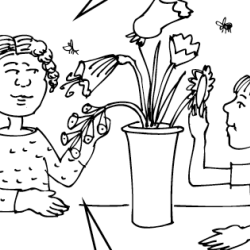Source Institutions
Source Institutions
Add to list Go to activity
Activity link broken? See if it's at the internet archive

This activity (on pages 24-29) combines science and art to introduce learners to how different animal pollinators spread pollen from one plant to another, and how certain shapes, colors, and smells of different flowers attract particular pollinators. In Part One, learners draw and label a flower based on a Pollinator Chart, then build the flower. In Part Two, learners survey others in their class or group to see if they can tell which kinds of pollinator their model flower would attract.
- 30 to 45 minutes
- 1 to 2 hours
- $1 - $5 per group of students
- Ages 8 - 14
- Activity, Model
- English, Spanish
Quick Guide
Materials List (per group of students)
- pen or pencil
- construction paper
- scissors
- glue
- tape
- markers
- tissue paper
- pipe cleaners
- additional art materials of your choice
Subjects
-
Life Sciences
-
Diversity of Life
- Plants
- Animals
-
Ecology
- Ecosystems
- Populations
-
Diversity of Life
-
Mathematics
-
Data Analysis and Probability
- Data Collection
-
Data Analysis and Probability
Informal Categories
- Arts and Crafts
Audience
To use this activity, learners need to:
- see
- see color
- read
- touch
Learning styles supported:
- Involves teamwork and communication skills
- Links STEM to other topics of interest such as arts and humanities
- Involves hands-on or lab activities
Culture, ethnicity, and gender
-
Girls
- Explicity developed for this group
Other
Foreign language versions of this resource:
Components that are part of this resource:
Includes alignment to state and/or national standards:
This resource is part of:
Access Rights:
- Free access
By:
Source Collection
- Science After School Consumer's Guide
Rights:
- All rights reserved, University of Nebraska State Museum and Nebraska 4-H, 2001
Funding Sources:
- NSF Informal Science Education Program, 9909496
- Howard Hughes Medical Institute
